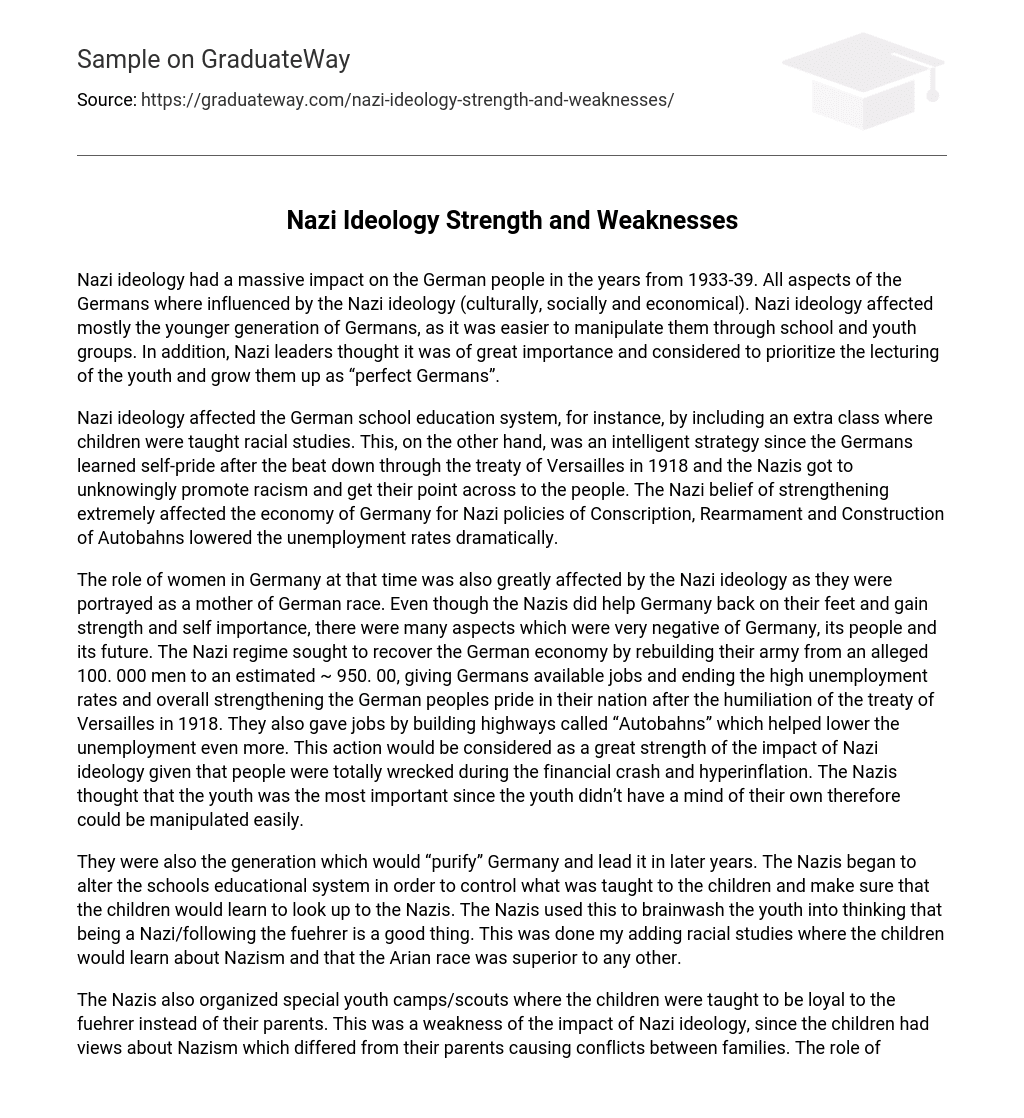The years from 1933-39 saw a significant impact on the German people from Nazi ideology. The influence was widespread, affecting all aspects of German society including culture, social life, and the economy. Particularly, the younger generation of Germans was targeted, as they were more easily manipulated through school and youth groups. The Nazi leaders emphasized the importance of educating and molding the youth into “perfect Germans.”
The German school education system was affected by Nazi ideology, including the inclusion of a racial studies class. This addition aimed to restore self-pride in Germans following the humiliation of the Treaty of Versailles in 1918 and subtly promote racism as part of Nazi messaging. The belief in strengthening held by Nazis also had a significant impact on the German economy, reducing unemployment rates through policies like conscription, rearmament, and autobahn construction.
The Nazi ideology greatly impacted women in Germany during that time, portraying them as the mothers of the German race. While this helped Germany recover and regain strength, it also brought negative consequences for the country, its people, and its future. The main objective of the Nazi regime was to rebuild the army from 100,000 men to approximately 950,000 in order to revive the German economy. This not only created job opportunities for Germans but also reduced high unemployment rates and increased national pride after being humiliated by the Treaty of Versailles in 1918. Additionally, constructing highways called “Autobahns” provided more employment prospects and relieved unemployment caused by financial crash and hyperinflation. Moreover, manipulating youth who were seen as lacking independent thought was deemed crucial according to Nazi beliefs.
The Nazis aimed to shape the future of Germany by influencing the thoughts of younger individuals. They accomplished this by implementing extensive modifications to the educational system, ensuring that children were instructed to idolize the Nazi regime. Brainwashing played a crucial role in achieving this goal, as the Nazis introduced racial studies that endorsed Nazism and propagated the belief in Aryan superiority over other races.
Under the Nazi regime, special youth camps and scouts were created to indoctrinate children with loyalty to the fuehrer instead of their own parents. Consequently, this caused discord within families as the children’s beliefs in Nazism differed from their parents’. In Nazi Germany, women were primarily assigned the role of being mothers for the nation. Propaganda aimed to encourage women to bear more children as a means of expanding the population of the “Perfect German” race across the entire country.
During Hitler’s reign, he believed that the main purpose of women was to bear children who would become his future followers and soldiers, which could be seen as a strength considering the declining German population. However, this perspective also led to the limited rights given to women in Nazi Germany. Another damaging aspect of Nazi ideology was the discrimination and persecution faced by individuals of Jewish background or descent. Propaganda was used by the Nazis to target and harass Jewish and other ethnic minority groups, whom they categorized as lower-class races.
The Nazi party effectively used propaganda to shift blame onto Jews for various issues, including economic troubles, the loss of the Great War, and the communist threat against Nazi Germany. This propaganda was so successful that many Germans believed it was necessary to have a pure Germany, which ultimately led to the horrific slaughter of approximately 6 million Jews and other ethnic groups deemed unfit for the ideal German identity. Once the Nazi party gained complete control, their goal was to restore traditional German culture in Germany.
This also meant that artists who expressed their emotions or political views through their artworks were persecuted if their art did not align with Nazi ideology or appeared to be anti-Nazi. This was a weakness because artists and filmmakers thrived during the Weimar Republic years, capturing significant moments and presenting them from a firsthand perspective. However, with the arrival of the Nazis, everything that seemed anti-Nazi or promoted ideas contrary to their agenda was heavily censored. The Nazis utilized cinemas and art as tools for spreading their own propaganda.
The Nazis imposed restrictions on films, allowing only those that manipulated German viewers and promoted the idea of German superiority. They also banned foreign movies and documentaries that presented alternative views. Despite being viewed as a weakness, this restriction on foreign art can also be seen as a strength of Nazi ideology. Preserving traditional culture is often regarded positively and may have benefited the German community after the moral breakdown following World War 1 (Ben Walsh).
In conclusion, Nazi ideology had both strengths and weaknesses. The greatest weakness was the abolishment of democracy in Germany during that time period. When Adolf Hitler became chancellor in 1933, he focused on consolidating power by utilizing the enabling act to declare himself dictator and prohibiting new parties from forming. This effectively established a “one-party” state in Nazi Germany where citizens were denied voting rights and freedom of speech, marking the end of democracy while resulting in the loss of previously granted rights during the Weimar Republic.
The Nazis successfully tackled Germany’s economic difficulties and rejuvenated the country’s pride, but this strength eventually turned into a vulnerability. Consequently, it triggered the emergence of a Second World War and ultimately caused the permanent collapse of the Nazi Party.
Works Cited
- Walsh, Ben. “Nazi Control Of Germany. ” Modern world history. London: Hodder Murray, 1996. 160-175. Print.
- “Nazi Ideology. ” http://www. nazism. net. N. p. , n. d. Web. 23 Feb. 2012. http://www. nazism. net/about/nazi_ideology/
-
“Nazi Foreign Policy 1933-1939. http://hsc. csu. edu. au. Charles Sturt University, n. d. Web. 23 Feb. 2012.





